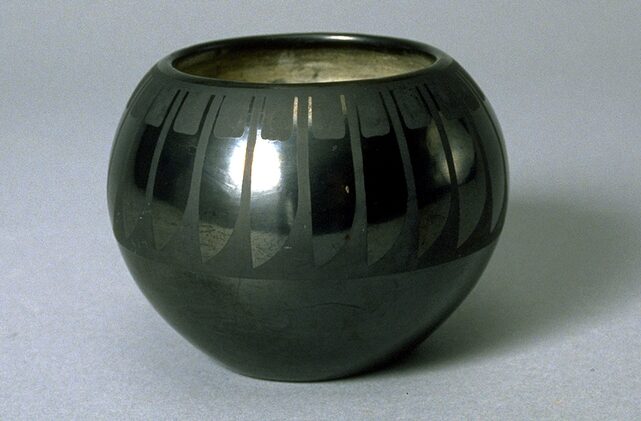Pot
Maria Martínez; Julian Martinez

Description
March 28, 2009
A skilled potter, Martinez spent the majority of her life making and teaching three generations of her family to make pots. In collaboration with her husband, Julian Martinez, she studied and recreated ancient ceramics, experimenting with firing and finishing techniques and producing vessels with a unique ebony finish. Martinez reintroduced to her people the art of pottery making, which was facing extinction, and her style became world famous.
Coiled, smoothed, and shaped by Maria, this pot has a swollen belly that yields at either end to a tapered lip and foot. The vessel has been carefully burnished, a process by which a smooth stone is rubbed against the pot’s surface prior to firing in order to align the clay particles. As a result the fired pots are lustrous and have a glossy sheen. The contrasting matte effect is achieved by painting slip (liquid clay) onto the pot after it has been burnished. In accord with the traditional division of labor, Julian usually applied decorative elements after Maria had completed the vessel. He called the geometric design of this pot “stylized feathers.
Subject Matter:
As a girl, Maria Martinez learned traditional pottery techniques, building vessels by hand, from her aunt, on San Ildefonso Pueblo, north of Santa Fe, NM. As a young adult, she developed her pottery shaping skills, creating fluid, balanced designs with thin walls. She and her husband Julian were influenced by excavations of ancient Puebloan sites above San Ildefonso, begun by Edgar Lee Hewitt, Director of the Museum of New Mexico. They developed new motifs for the decoration of their pots including this design. The feathers here were inspired by the designs of the Mimbres, a neighboring culture to ancestral Puebloan people. Maria and Julian also developed the black-on-black style seen here created by first shaping the vessel then applying slip and burnishing the slip with a stone, both skills Maria excelled at. Painting on designs in another iron-rich slip or a reduction of wild plants called guaco was a skill Julian had mastered. The vessels were fired in open pits with manure added as fuel and to reduce oxygen, helping create the rich black color. The burnished areas become shiny, the slip/guaco areas become matte.
Physical Description:
This small spherical pot with wide mouth is decorated in black-on-black style. Around the upper half is a feather design, which looks like individual feathers hanging down from the mouth forming a ring around the circumference.
Usage Rights:
If you are interested in using an image for a publication, please visit https://umma.umich.edu/request-image/ for more information and to fill out the online Image Rights and Reproductions Request Form.